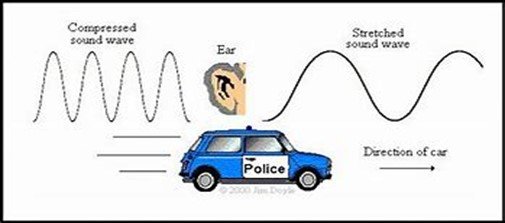Consider a police car sounding a siren and moving towards you. How do the siren pitches change when it’s approaching, passing by you, and receding? Nonetheless, the variations in these siren pitches are a product of the Doppler effect. Doppler effect is an interesting phenomenon where wavelengths and frequencies of wave energy shift relative to the change in the wave source’s positions and the observer. An excellent application of the Doppler effect is in the use of traffic police radar speed guns.
Doppler effect in radar explained.
Generally, a Doppler radar is used to determine the velocity of an object in motion. It achieves this by sending out a radio signal that returns to the radar after bouncing off the target object. The rate at which the object’s motion alters this returning radio signal’s frequency can be analyzed to figure out its speed. This variation between the observed and emitted frequency of the radio wave signal can be used to calculate the object’s distance from the radar and its velocity.
Doppler effect in a radar speed gun
Traffic police officers use radar speed guns to determine the speed of moving vehicles. These radars are usually hand-held. Regardless of how fast your speed, they can quickly tell whether you’re within the speed limit. A radar speed gun is used to figure out the velocity of moving target objects at which it’s pointed. The variation in the frequency of the returning radio wave is a good indicator of an object’s speed.
When a car moves towards the radar speed gun, the car compresses the radio waves sent as the distance decreases. Therefore, each signal takes less time to reach the car than the previous wave signal. The decrease in arrival time between successive radio signals increases the wave frequency. Thus, the waves are compressed.
Conversely, when a car moves farther away from the radar speed gun, each radio wave signal is sent to a position farther from the speed gun than the previous signal. The increase in arrival time between successive radio wave signals makes the waves spread out (increased wavelength), thus lowering wave frequency.
Doppler effect in different media
Sound and radio waves require a medium of propagation. Thus, the shifts in frequency and wavelengths of these waves are relative to both the observer and the wave source’s positioning. Therefore, the overall Doppler effect is a product of the relative motion of the medium, the onlooker, and the wave source. These determinants of the total Doppler effect are analyzed separately.
Unlike sound and radio waves, light waves do not require a medium of propagation to change positions. For this reason, only the relative change in motion between the light wave source and the observer should be analyzed to determine the overall Doppler effect.
Application of Doppler effect in different radar types
- Radar speed guns have found application in law enforcement by the police, mainly traffic police for speed limit enforcement.
- Moreover, radar speed guns are used in professional sports coordination, especially in cricket, to determine bowling speeds.
- They are also used in the determination of speeds at which tennis serves are made.
The bottom line
In conclusion, the Doppler effect is the relative change in wavelength and frequency of a wave signal due to the shift in relative motion between the wave source and the observer. The frequency of the signal returned after it bounces off of the target object can be analyzed to determine an object’s velocity. The use of radar speed guns in speed limit enforcement by traffic police officers is a classic example of applying the Doppler effect.




